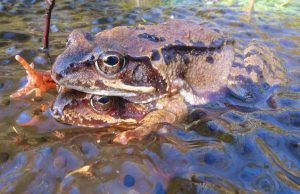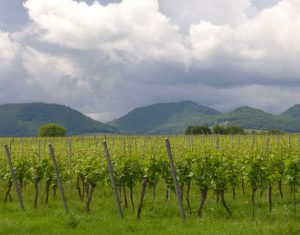In this post, Kathrin Theissinger and Carsten Brühl inform about their recent paper “Amphibian population genetics in agricultural landscapes: does viniculture drive the population structuring of the European common frog (Rana temporaria)?”.
We recently published a paper on the potential impact of viniculture on the population structuring of the European common frog (Rana temporaria) as part of the DFG project “Amphibians in agricultural landscapes: chemical landscape fragmentation implemented in a habitat modeling approach”. In this study, we analyzed microsatellite data of breeding populations within the vinicultural landscape around Landau/Pfalz and tested for significant correlation of genetic population differentiation and landscape elements, including land use as well as roads and their associated traffic intensity, to explain the genetic structure in the study area.
Our analyses suggest that the viniculture landscape has to be considered as a limiting barrier for R. temporaria migration. Here, arable land may act as a sink habitat, inhibiting genetic exchange and causing genetic differentiation of pond populations in agricultural areas.
In viniculture, pesticides could be a driving factor for the observed genetic impoverishment, since pesticides are more frequently applied than any other management measure and can be highly toxic for terrestrial life stages of amphibians. Following the precautionary principle it may be advisable to reduce or avoid pesticide applications during amphibian migration phases and to mitigate pesticide contamination of amphibian breeding ponds.
In the ongoing project we use a landscape genetics approach to further assess the impact of chemical landscape fragmentation in viniculture for two additional amphibian species with varying dispersal abilities (Bufo bufo and Lissotriton helveticus). We measure and compare gene flow rates and genetic diversities among breeding pond populations. Our genetic data is complemented by a telemetry study to investigate the migration direction from the aquatic to the terrestrial habitat. Moreover, we conduct acute toxicity tests of the vinicultural fungicides on different developmental stages of R. temporaria. Additionally, terrestrial mesocosm experiments are running to investigate the chemical uptake from contaminated soil by adult frogs.
The paper authored by Patrick P. Lenhardt, Carsten A. Brühl, Christoph Leeb and Kathrin Theissinger was published open access in PeerJ.
For students who are interested in participating in some part of this highly integrative project, please contact Christoph Leeb (leeb@uni-landau.de).


